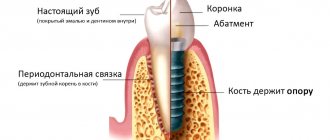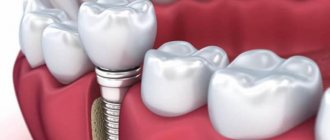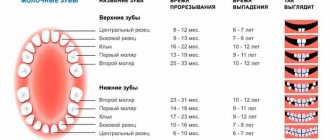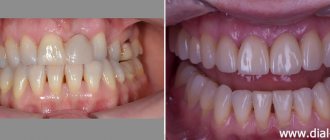From this article you will learn:
- what crowns are better to put on the front teeth,
- pros and cons of different crown options,
- How much does it cost to insert a front tooth?
When replacing anterior teeth, patients always place quite high demands on the aesthetics of dental crowns. The most important of them is that crowns on the front teeth should not be noticeable against the background of your own teeth, matching them in shape, color and transparency. The second important point is that crowns should not cause the gums to appear blue around them, because this will lead to its extremely aesthetically unsatisfactory appearance.
Today in dentistry there are only a few aesthetically acceptable options for prosthetics of anterior teeth. We are talking about prosthetics with metal-ceramics, zirconium crowns, as well as ceramic crowns “Emax” (glass-ceramics). Moreover, patients are equally often dissatisfied with both metal-ceramic and ceramic crowns, and below we will tell you why this happens and how to choose the most suitable option for you.
Metal-ceramic crowns for the front teeth: photo
The reasons for patient dissatisfaction lie not only in the low quality of work, but also in the initially incorrect choice of the type of crown, for example, not taking into account the level of transparency of the patient’s tooth enamel. The difficulty of choosing also lies in the fact that each of the types of crowns mentioned above (depending on the quality of the materials used and the manufacturing method used) can have either good or bad aesthetics. For example, let’s take economy-class metal ceramics made from budget ceramic mass “Duceram” (Germany).
Such metal ceramics can be found at an average price of 10,000 to 12,000 rubles. At the same time, the aesthetics of metal-ceramics made from budget ceramic mass will be very different from crowns that used more expensive ceramic mass, for example, “Noritake” (Japan), “Ivoclar” (Liechtenstein) or “Vita” (Germany). The average price for such metal ceramics in Moscow will be from 15,000 to 18,000 rubles. And if the metal ceramics were also made with the so-called “shoulder mass”, then you will have to add about 5,000 rubles to the price.
Important: we point out that within each type of crown there are numerous manufacturing options, the aesthetics of which will largely depend not only on the professionalism of the doctor and dental technician. Really good aesthetics will require more expensive materials and more labor-intensive manufacturing methods. But on the other hand, even choosing expensive ceramic crowns will not be an unconditional guarantee that you will get good aesthetics (since everything has its own nuances, which doctors often keep silent about).
What are the features of prosthetics for anterior teeth?
Any specialist understands perfectly well how important his smile is for a person, because it is a kind of business card, which means it is the first thing we pay attention to when meeting or getting to know each other. A lot depends on its beauty: the success of the transaction, personal relationships and - most importantly - the psychological state of its owner. Therefore, every time doctors are faced with the need to restore a front tooth, they are faced with an important and difficult task: to quickly and efficiently carry out the procedure. Prosthetics of the front tooth requires not only the correct recreation of the function, shape and color of the tooth, but also requires paying special attention to the “pink aesthetics”, that is, the gum.
What to prepare for
Dental implantation is a technique that does not have the disadvantages of previous generations of prostheses. Implantologists consider it as the only way to restore lost teeth that does not harm the health of the oral cavity and has an unlimited (usually lifelong) service life.
Important! No other prosthetic method provides such high aesthetics as implantation.
But it should be taken into account that dental implantation is not a simple procedure during which an implant is simply inserted in place of the missing unit. The future tooth (more precisely, its root) must have a certain size, the proper position and direction, and a strictly defined inclination are selected for it.
In addition, it is necessary to restore all the tissue surrounding the tooth - and, first of all, bone tissue and gums. It is this comprehensive approach that allows us to achieve reliability, impeccable aesthetics, and durability of implant treatment.
Implantation is a slow process, except for one-stage implantation, as well as the “all on 4” and “all on 6” techniques. Treatment usually involves several stages, despite the common name of "two-stage" surgery.
Treatment always begins with diagnosis, which is the first and, perhaps, the most important stage that determines its outcome. Based on the results of the preliminary examination, a decision is made on implantation technology, types of implants, and the details of the upcoming operation are thought out.
Important! It is necessary to prepare for the fact that during the implantation process you will have to go through several stages. A standard scheme applies to all patients, so we have prepared a detailed description of each stage of dental implantation.
In what cases are veneers used to restore front teeth?
If the problem is minor damage in the area of the front teeth, such as cracks or minor chips, as well as in cases where a person is not satisfied with the shape and color of the front teeth, it is advisable to correct the defect by installing ceramic veneers. A veneer is a thin porcelain plate no more than 0.3 mm wide, which is fixed to a ground tooth using composite cement. Modern materials from which veneers are made are very durable, hypoallergenic and can imitate almost all shades of natural enamel, as well as its transparency. Many modern dental clinics in Moscow, which provide prosthetics for front teeth using this orthopedic design, can offer the installation of veneers during one visit to the doctor. With careful care, such ceramic restorations will serve their owner for at least ten years.
Stage 2: preparatory
Details of the preparatory stage may vary significantly for different patients due to differences in the condition of the oral cavity in general and the jaw bone tissue in particular. Most people planning to have implants require dental hygiene.
Sanitation is carried out with the aim of eliminating bacterial plaque from the surface of tooth enamel, since a successful implantation operation requires, if not sterility, then maximum cleanliness of the oral cavity. The presence of pathogenic microflora can provoke the development of inflammation, which should be avoided at any stage of implantation.
Hygienic cleaning is done using ultrasound when there is existing tartar, soft plaque is removed using Air Flow technology. The price of such reorganization is from 6,000 rubles.
At the preparatory stage before implantation, it may also be necessary to remove teeth, treat caries and periodontitis. The price of each procedure is calculated separately.
But the most serious step before installing implants may be bone grafting surgery. Very often it is impossible to do without it due to a lack of bone due to its resorption - resorption, natural loss. Bone volume can be greatly reduced if a tooth is lost or removed long ago, or due to individual characteristics.
As a rule, bone grafting is performed in the case of classical two-stage implantation, which places high demands on the quality of the jaw bone tissue. In addition, bone grafting is almost always necessary for patients who have lost teeth a year or more ago. During this period, the bone undergoes rarefaction and becomes brittle, which creates certain difficulties with fixation of implant roots.
There are several methods for performing bone grafting, or osteoplasty, using different materials. Therefore, the price will depend on the selected operation technology. There are 3 options in total:
- sinus lift;
- directed regeneration;
- autotransplantation.
What are Lumineers and when are they used?
Lumineers are another type of orthopedic plates designed primarily to correct the color and shape of the tooth surface. The installation of lumineers, unlike veneers, is carried out in one visit and does not involve grinding of the dentition. That is why there is no need to wear temporary structures before installing them. Lumineers also have an undeniable advantage over composite restorations: thin ceramic plates do not darken over time.
However, there are also disadvantages. Since lumineers are installed on an unground surface, it is sometimes very difficult to achieve a tight fit to the teeth. In addition, the tooth on which the lumineer is attached differs from the natural dentition in size and shape, so it is not recommended to correct local defects with its help.
Stage 4: rehabilitation after implant installation
The rehabilitation period is the time during which the implant root takes root in the patient’s own tissues. Only after osseointegration is completed can one proceed to the orthopedic stage and place permanent crowns.
It is impossible to shorten the healing time of implant roots, even if you take special calcium supplements and other medications. Depending on individual characteristics, it can average 3-6 months, although in most cases it takes at least six months.
The implantologist may recommend regular visits to the clinic to monitor the survival of the implant root (or roots). However, in the absence of discomfort and complications at the rehabilitation stage, the patient makes the next visit to the clinic at the very end. Next, a date is set for placing a gum former on the implant.
How is prosthetics performed for severely damaged front teeth?
Modern prosthetics of anterior teeth in many cases involves the use of an old proven method - installing a crown. This prosthesis is a protective frame that is put on the ground remaining part of the tooth and completely repeats the shape and color of the lost crown part. The need to use this orthopedic design arises in cases where the tooth is destroyed by more than 50%. Before installing it, the doctor grinds down the tooth (what’s left of it), and only then puts on the “cap,” that is, the crown itself. Modern specialists prefer to prosthetize the front teeth using the most aesthetic type of crowns on a frame made of lithium disilicate, feldspathic ceramics and zirconium dioxide.
Materials for production
The correct choice of material determines how long the crowns will last and how correctly they will function. All modern materials differ from each other not only in cost, but also in physical properties.
An example of what artificial teeth look like
All properties allow you to install the prosthesis on a specific area. There are materials that are used only for the front teeth, and there are also those that can be used to restore only the chewing group.
Front row restoration material
The front teeth do not experience increased load, but crowns must meet all aesthetic requirements.
That is why it is recommended to use the following materials for reconstruction:
- Metal ceramics . This is a metal frame with several layers of ceramic on it. Increased wear resistance, long service life, aesthetic properties meet all requirements. The cost of such a design averages six thousand rubles.
- Porcelain. For manufacturing, pressing is used, this is what gives the products resistance to mechanical stress. Due to the absence of metal, the structure looks almost the same as a real tooth. Another main advantage of the product is hypoallergenicity. The metal is not strong enough, but the coating perfectly replaces a real crown.
- Plastic. This is one of the most short-lived materials, which can collapse even with minor impact. Due to the porous structure of the enamel, dyes from food penetrate inside, so the aesthetics of the crown quickly loses its appearance.
An example of work performed in a person's mouth
The patient decides which material to choose, because the cost differs significantly between them.
Material for crowns on chewing teeth
The load on these teeth is the greatest, which means that for restoration, materials that can withstand mechanical stress should be used. Metal-ceramics, which was described above, can also be included here.
An example of what ceramic crowns look like
In addition to this, there are other types, they are intended exclusively for these teeth:
- Zirconium dioxide. The material is no different from a natural tooth: transparency and color are transmitted with one hundred percent accuracy. It is possible to restore both the anterior and posterior dental rows. Abrasion resistance is high. Such qualities correspond to a high cost, which in some clinics can reach thirteen thousand rubles.
- Metal. The name of this material speaks for itself. To make crowns, only metal is used; there is no additional coating or spraying. The physical properties are high, everything is excellent for chewing teeth. Due to low aesthetics, it cannot be used on the front row.
- Metal composite. The material is not in demand. For manufacturing, a metal frame is taken, and several layers of plastic are applied on top. This design can only be used on chewing teeth and only temporarily. The thing is that there is no sufficient adhesion to the metal; with a slight impact, the product can fly off. As practice shows, crowns last for six months.
Example of metal-plastic crowns
To restore the entire dentition, combined structures can be used; they include crowns made of different materials.
Interesting! The combination of metals can be varied: ceramics with cermets or metal.
How are missing or severely damaged teeth restored?
Dental implantation is considered the most reliable and optimal option for restoring missing or unrecoverable incisors. Implants do not require grinding of adjacent teeth, and their installation has virtually no contraindications. Implantation is considered the best option for prosthetic treatment of anterior teeth for periodontitis. When reconstructing teeth in the anterior region, specialists prefer to work using an accelerated method, that is, to carry out one-stage implantation. It makes it possible to completely restore a tooth in one visit to the doctor and maintain the correct contour and volume of the gums. The patient is given an implant, and immediately after that a temporary crown is installed, which completely restores the aesthetics of the smile. However, it must be remembered that one-stage implantation is possible only under certain conditions. Otherwise, if for some reason it is impossible to immediately install a temporary crown, the doctor still does not let the patient go “with a hole instead of a tooth,” but temporarily covers it with a removable denture.
Ancient dentures
The first prototypes of dentures for the upper jaw were discovered during excavations of Egyptian tombs. After carefully studying these impressive artifacts, scientists came to the conclusion that even in ancient Egypt, priests wondered “How to make dentures” and widely used slave teeth and ivory dentures for this purpose, which were tied with wire to adjacent teeth. In the tombs of the Etruscans (9th-39th centuries BC), during excavations in the city of Tarquinia, a denture for the jaw was found, made from animal fangs with fastenings in the form of gold rings. And only in the 11th century AD. The beginning of dental prosthetics, as a separate direction in dentistry, was laid by the Arab surgeon Abul-Kassem, who proposed splinting teeth with wire made of precious metals.
Further development of orthopedic dentures took place in Europe. In the 16th century, the French surgeon Ambroise Paré thought about how to install dentures and came up with designs consisting of interconnected artificial teeth made of ox bone, ivory and even wood. However, later, the teeth of deceased people, for example, soldiers who died during military battles, were more often used for prosthetics. The first porcelain dentures, most similar to modern ones, were made in the 19th century, but the bases for them were still made of wood, ivory and gold. It was only in 1848 that these materials were replaced by rubber. Our country has also made a significant contribution to the development of technology for the manufacture of dentures. Russian researchers introduced the production of dentures from acrylic plastic and discovered the suitability of stainless steel for the manufacture of fixed dentures.











